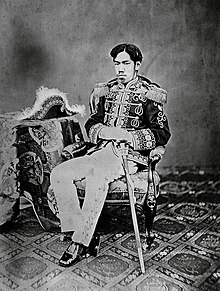 |
| The Meiji Emperor |
In Japanese constitution, it said Japanese emperor is a symbol of Japan. Actually present emperor does not have political power and the command of the army. However, in Meiji period emperor had a right to control the country. At that time, the emperor was symbol and leader of Japan.
Firstly, I will write about “Tenno history”. In Japanese myths found in the “Kojiki” and “Nihonshoki”, written in Nara period, two ancient gods Izanami and Izanagi created Japan. They made Japanese islands, ocean and also the many gods. They created a lot of gods from their body. Their tenth-generation descendant ‘Kanyamato-iwarebiko’ (神日本磐余彦) became the Jinmu emperor. The history of the Japanese empire started from him. He is one of the characters in Japanese myth. According to the tradition, he was born in Japanese god’s family and he died when he was 126 years old. He ascended on February 11th, 660 B.C. In Meiji period, the day was defined as National Foundation Day of Japan.
After the Jinmu emperor, the imperial family was Japanese monarch and the actual leaders of Japan. However, samurai influence was on the rise after Kamakura period. They ruled over Japan and finally Tokugawa family unified Japan in Edo period. Real political power passed to the samurai completely.
In 1853, Perry, who was an American sailor visited Uraga, Japan with four worships. Japan was forced to open country. At that time Sonno joi thought (respect emperor and expel foreigners) was spreading in Japan. Especially, the leading members were from Kyushu. They strived to overthrow the Bakufu government led by the Tokugawa family. Finally, in 1867 Bakufu was overthrown, and political power was returned to the imperial family again.
Secondly, in Meiji period, the societal role of Japanese Empire was changed; the emperor became ruler of Japan and created modern Japan.
In 1868, Meiji emperor ascended and Meiji period started. Meiji Tenno was 112nd emperor of Japan. He was born in 1852. His personal name was Mutsuhito. He liked waka poetry (和歌) and left 93,000 poems. In early Meiji period, Japanese government searched new style of Japanese society, so Japanese government deified Meiji Emperor to create new strong Japan that is centering on Meiji Emperor. Also they adopted an idea of Shinto as a form of nation. The idea of Shinto was used in many fields (for example, politics and culture) during Meiji period.
In Meiji period, Meiji emperor was leader of modern Japan and symbol of Japan. Meiji emperor and new government established many modern systems in Japan. In 1882, he set the army as emperor’s army and was head of the army. Before parliamentary system was started, he set a cabinet system, the organization system of cities, towns and villages and a bureaucracy. In 1889, Japanese constitution was published. During China-Japan war and Russia-Japan war he led the war in the field. At that time Japan’s policy was to increase the wealth and military. Japan concluded an alliance with England. Japan aimed to be equal with western countries.
In 1912, Meiji Emperor died of diabetes. He was 59 years old. Meiji Jingu shrine was built to the spirit of Meiji emperor.
Reference
Meiji Jingu. (n.d.). About Meiji Emperor. Retrieved July 24th from http://www.meijijingu.or.jp/about/3-4.html
(n.d.). Japanese myth; Kojiki Retrieved July 24th from http://www15.plala.or.jp/kojiki/
Hashizume Daisaburo (2013). 世界は宗教で動いている.Kobunsha
